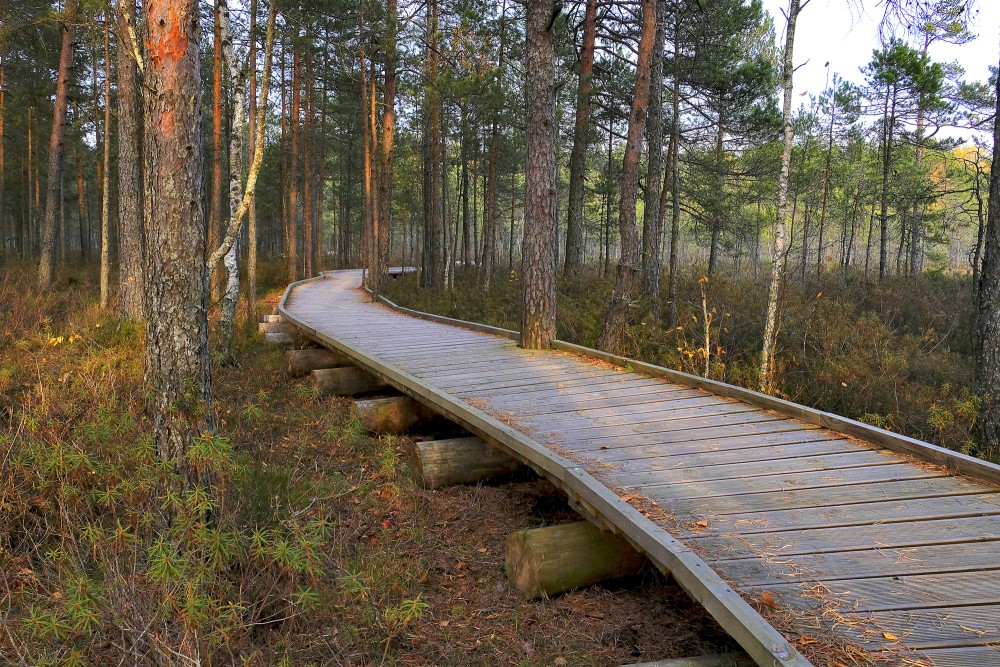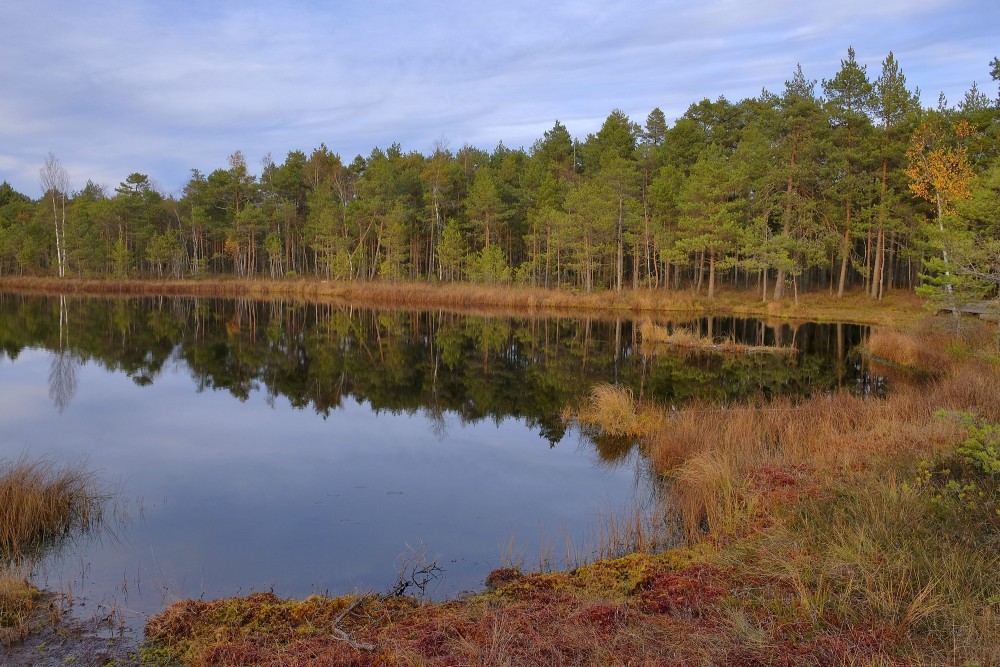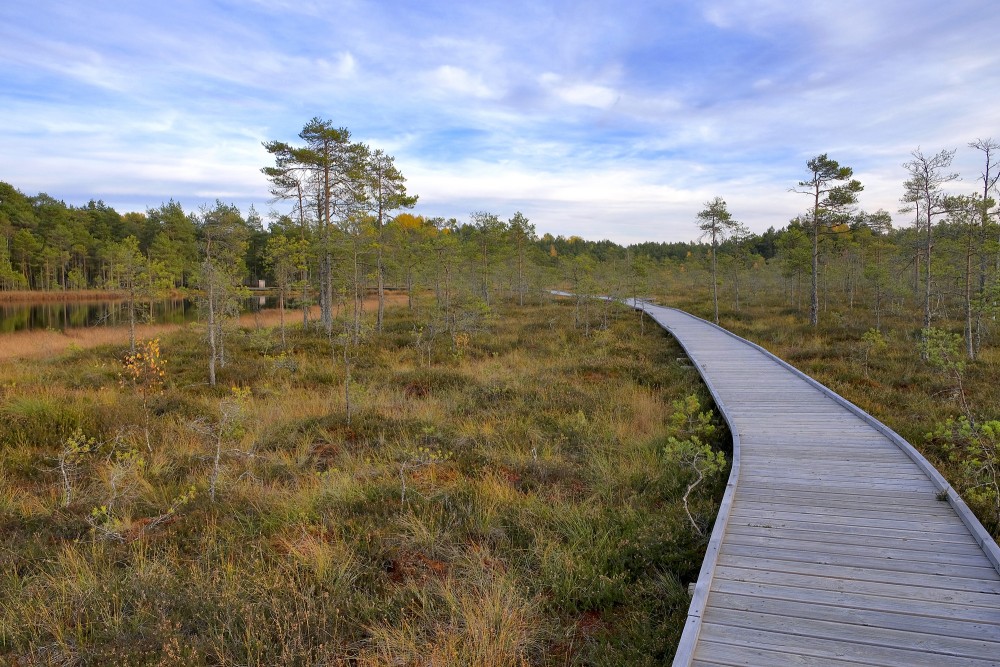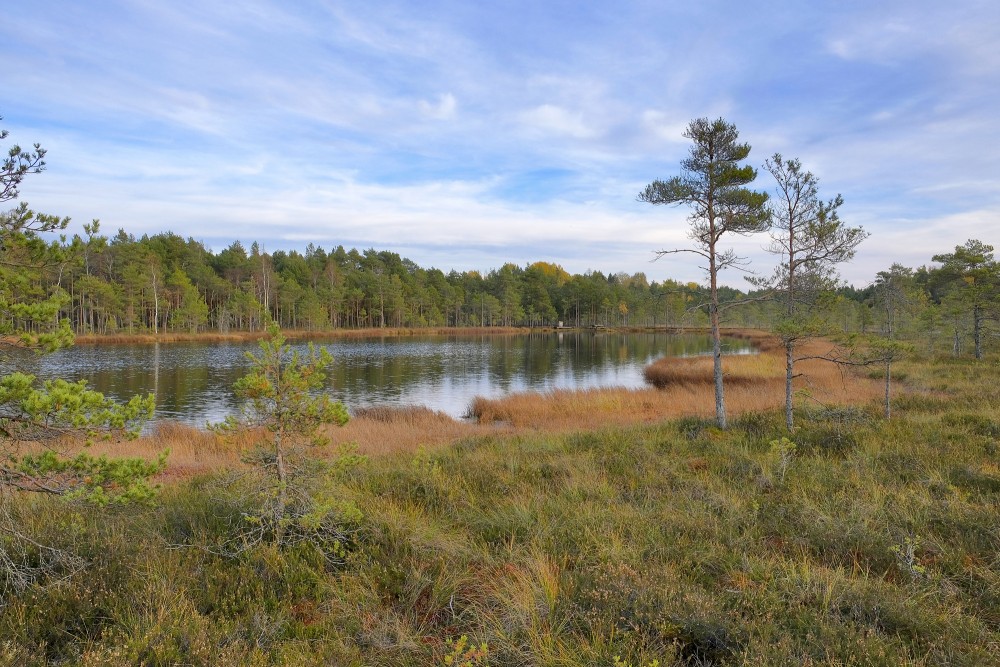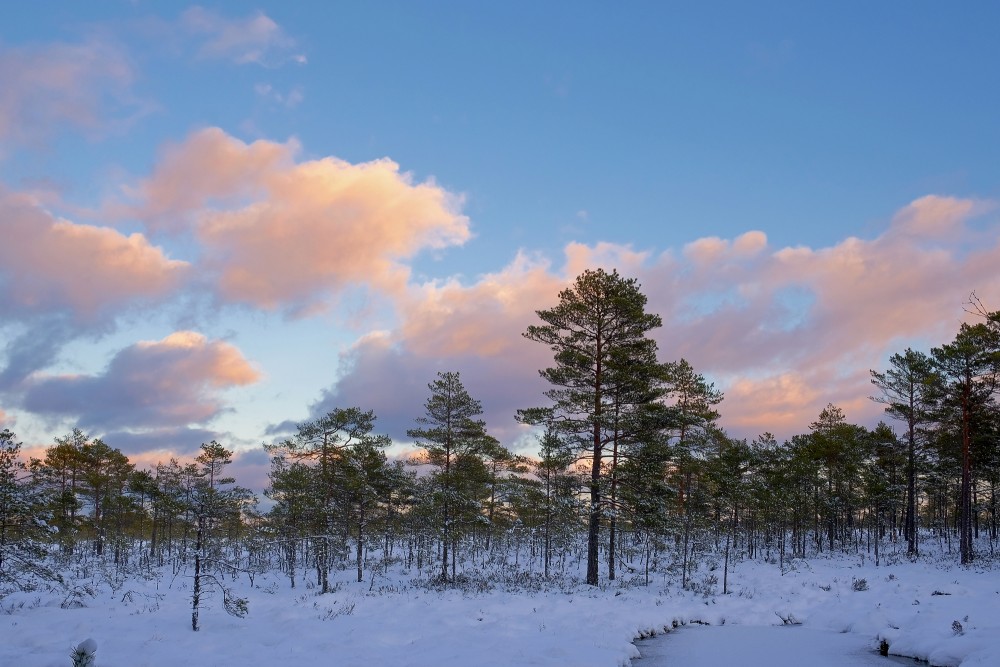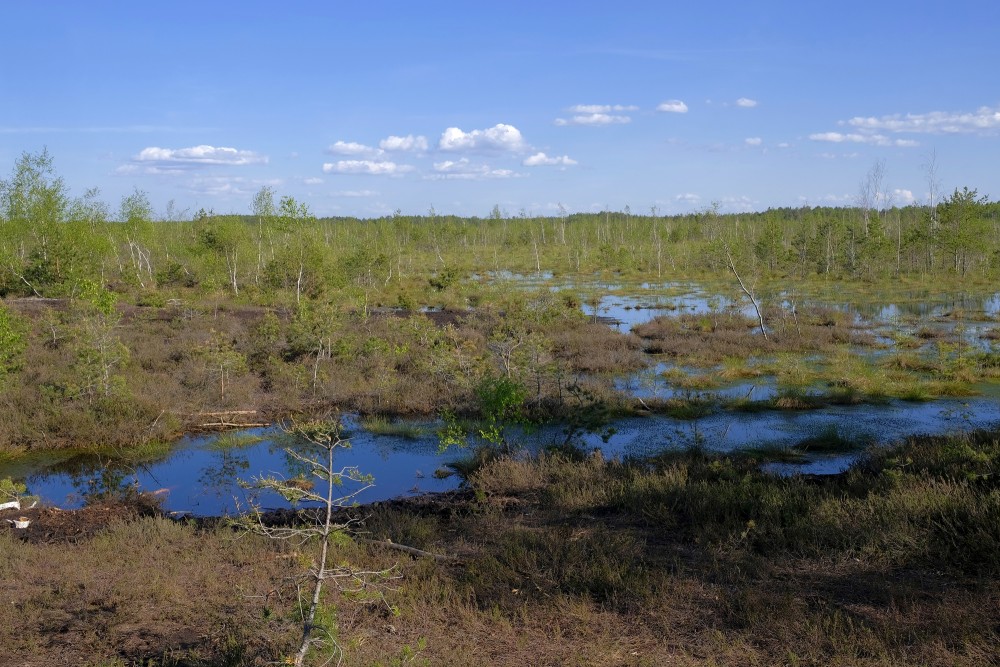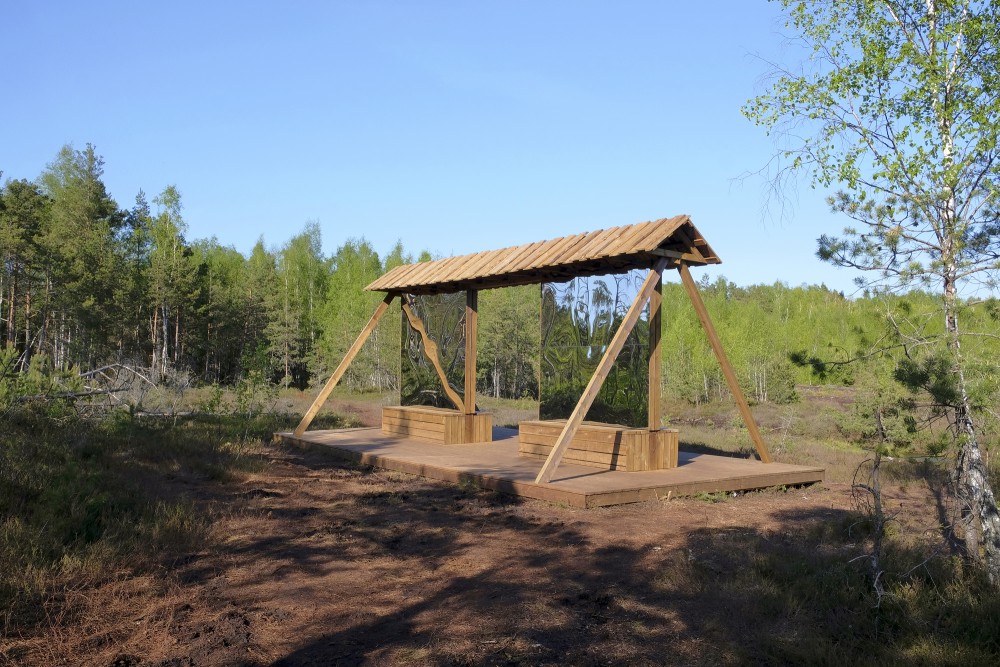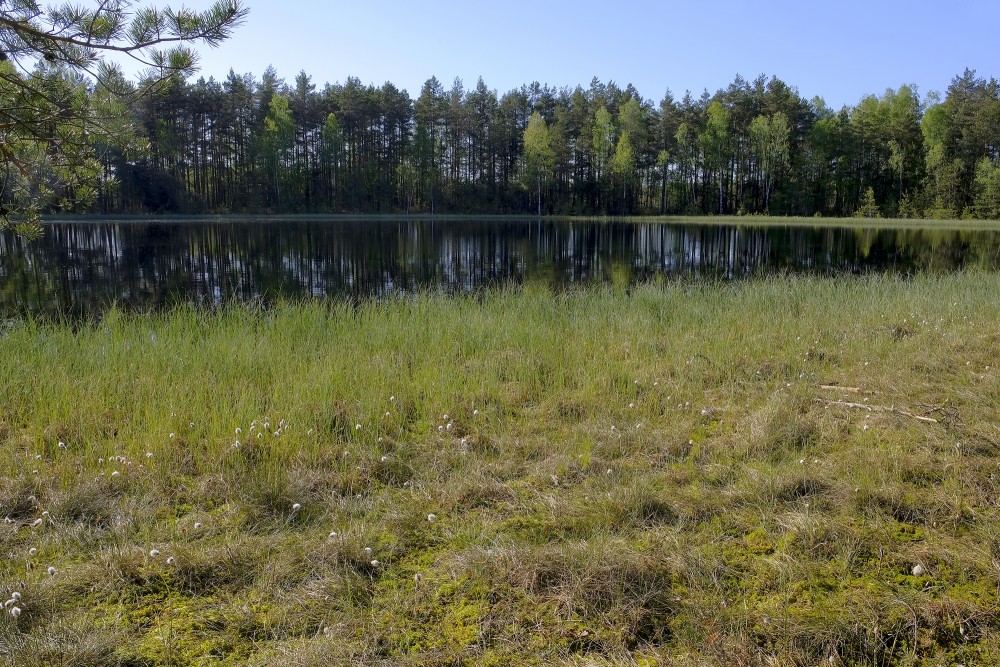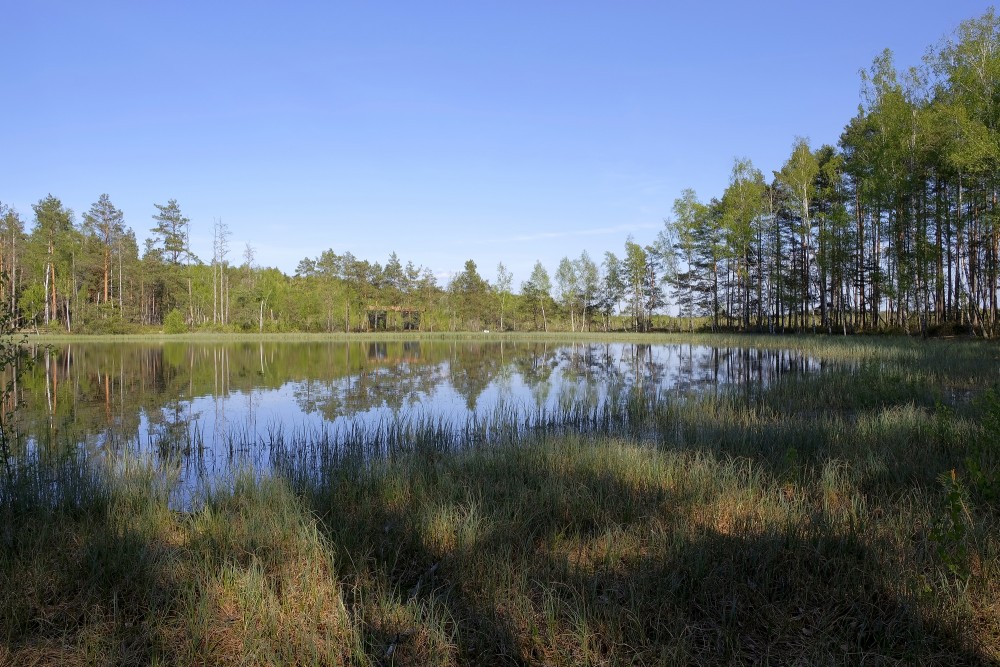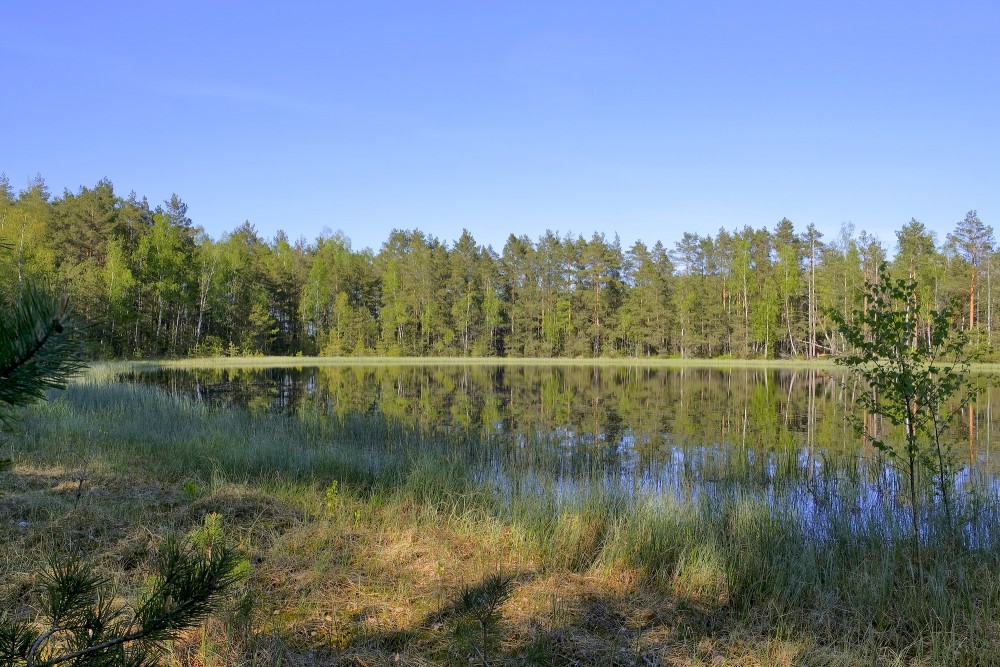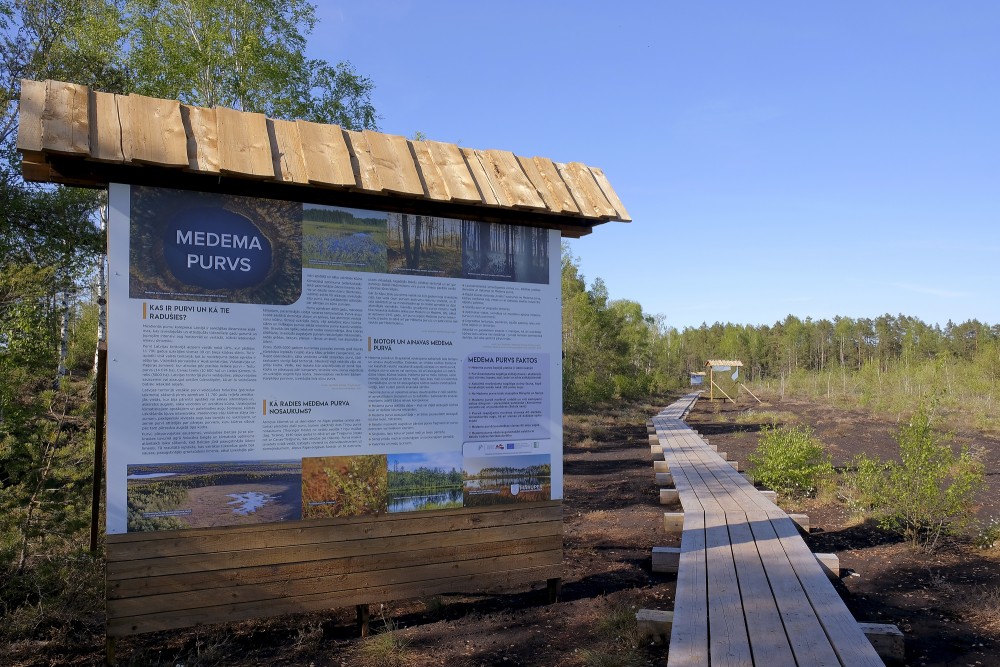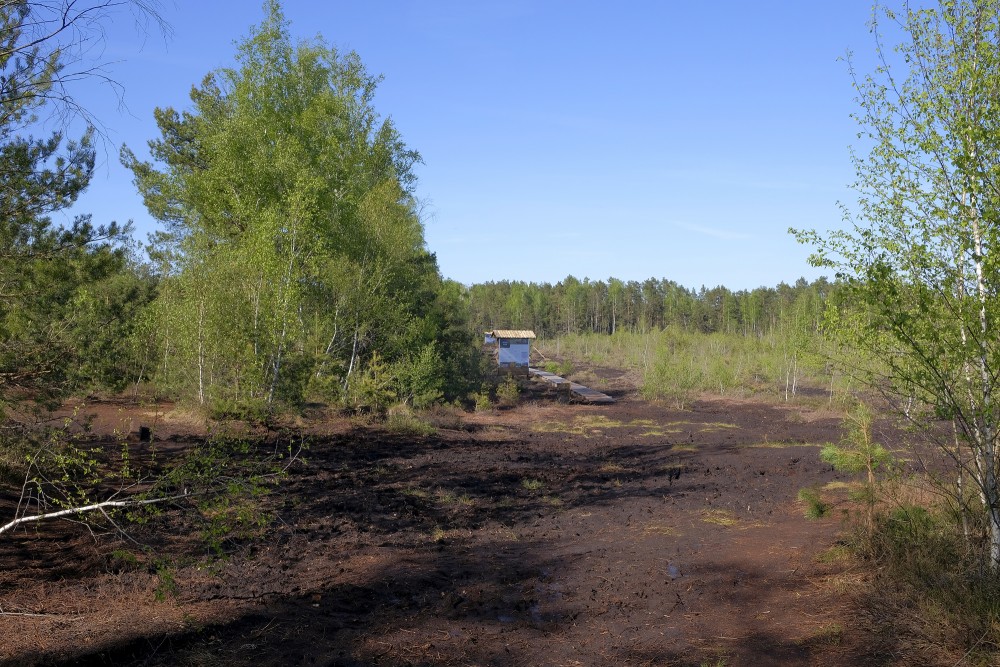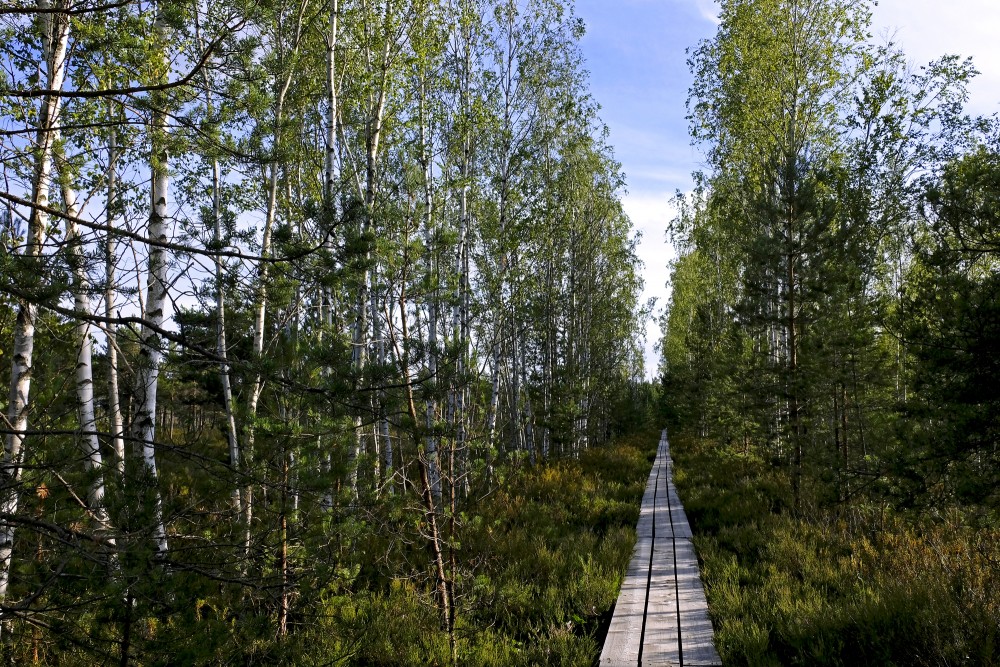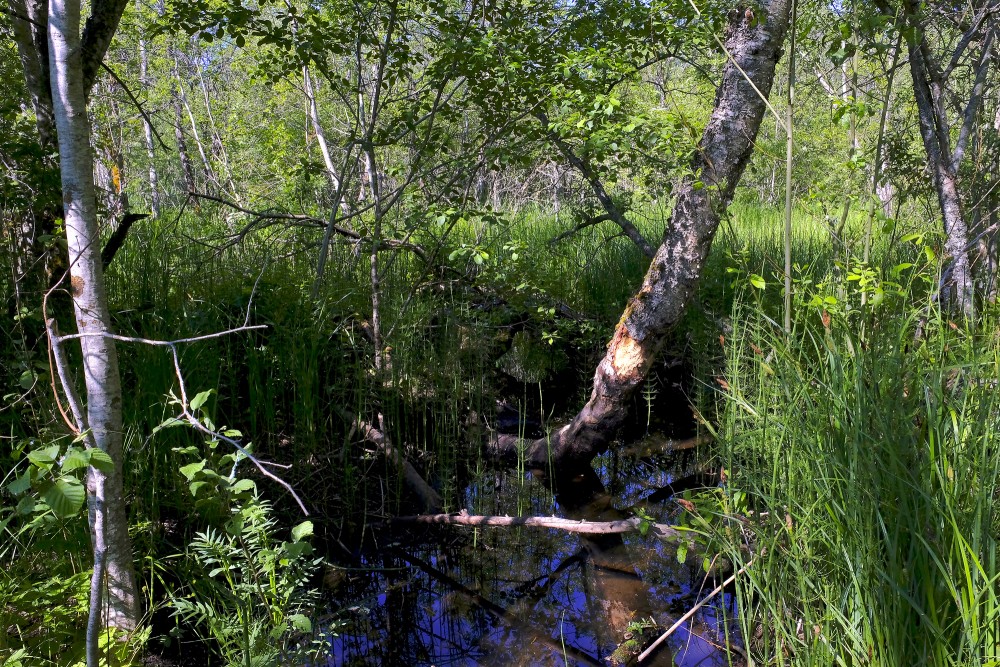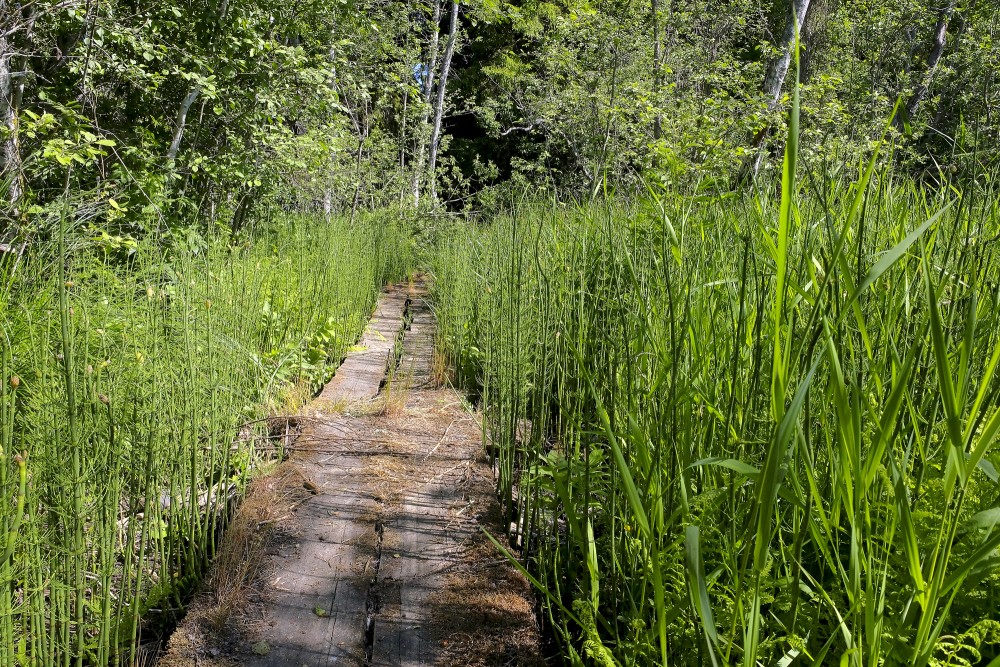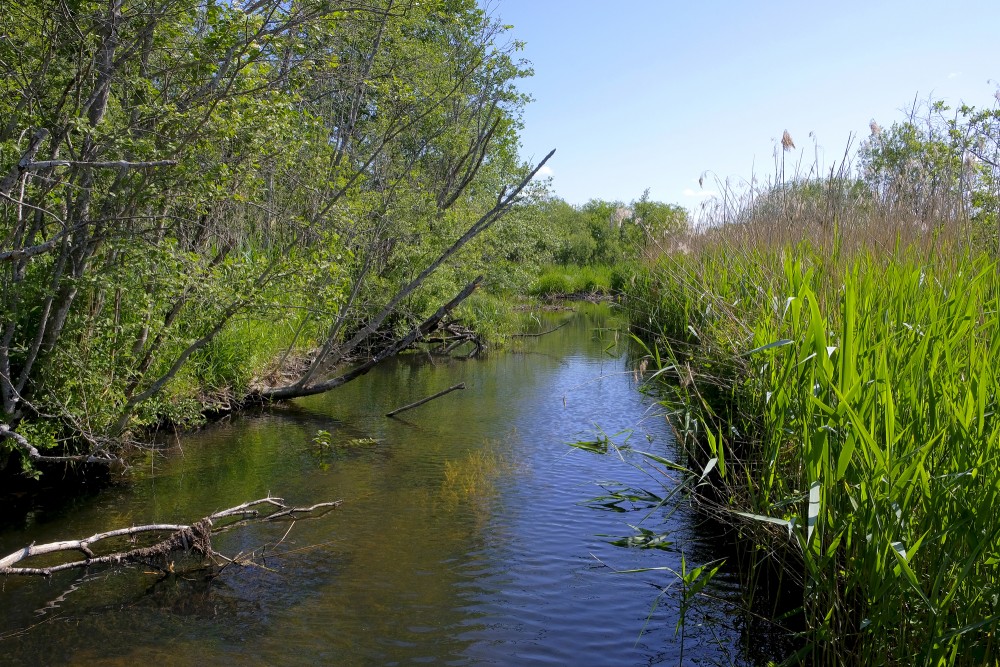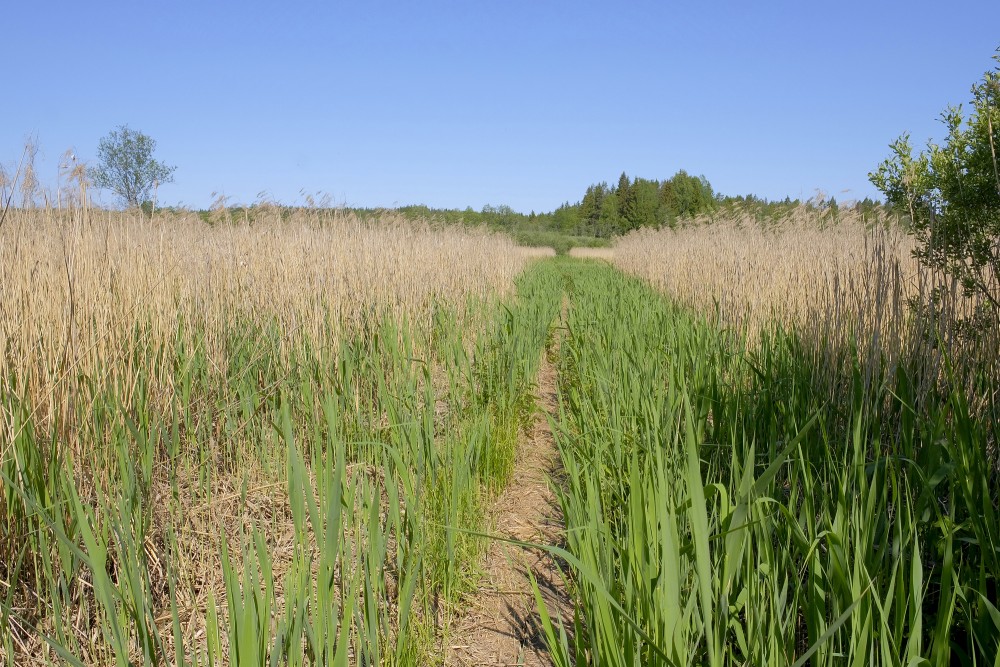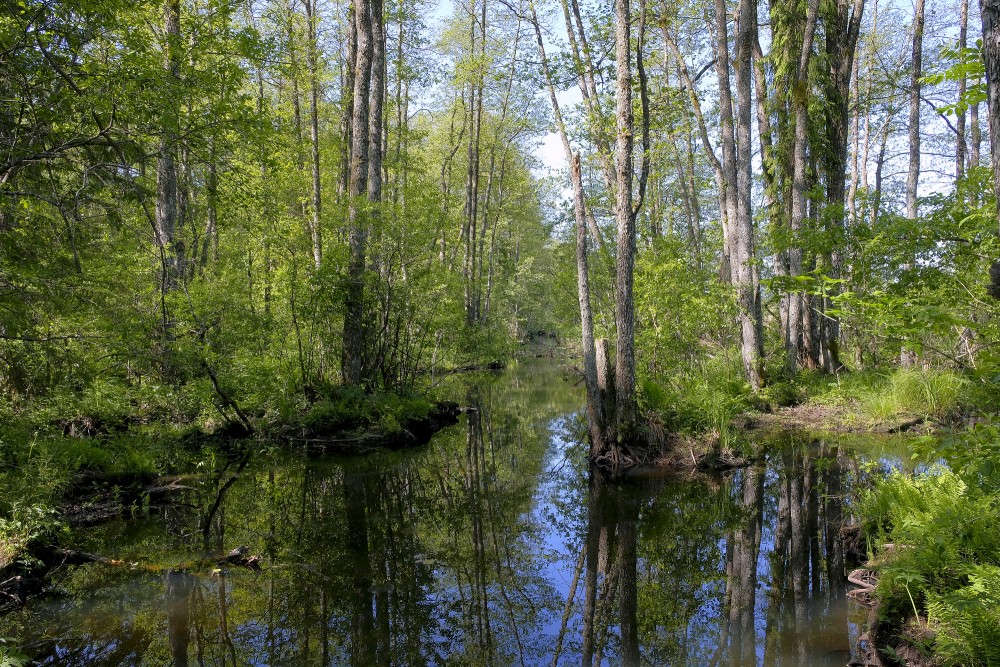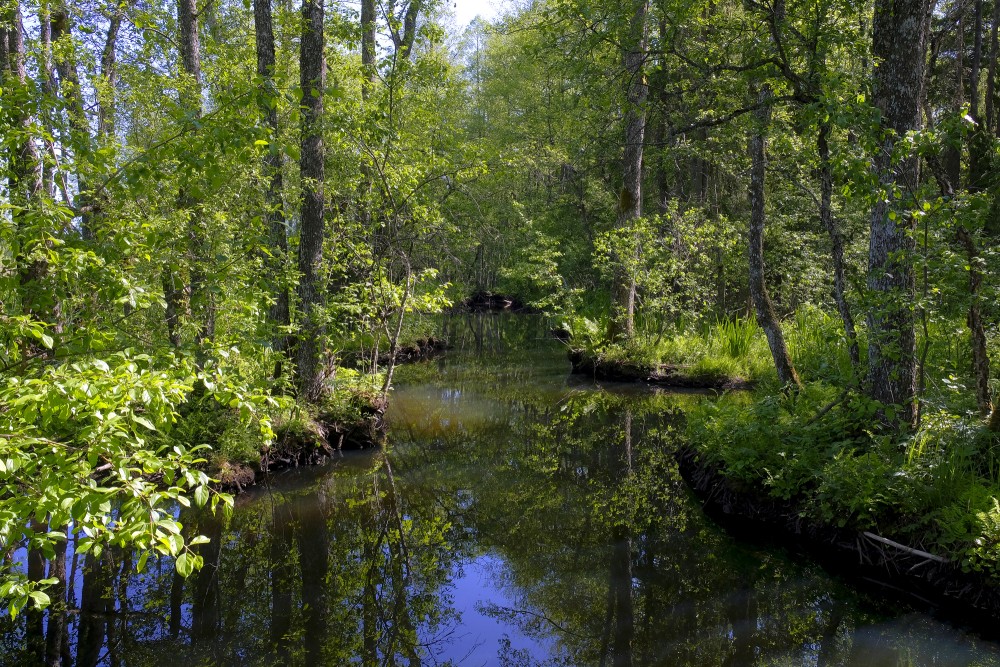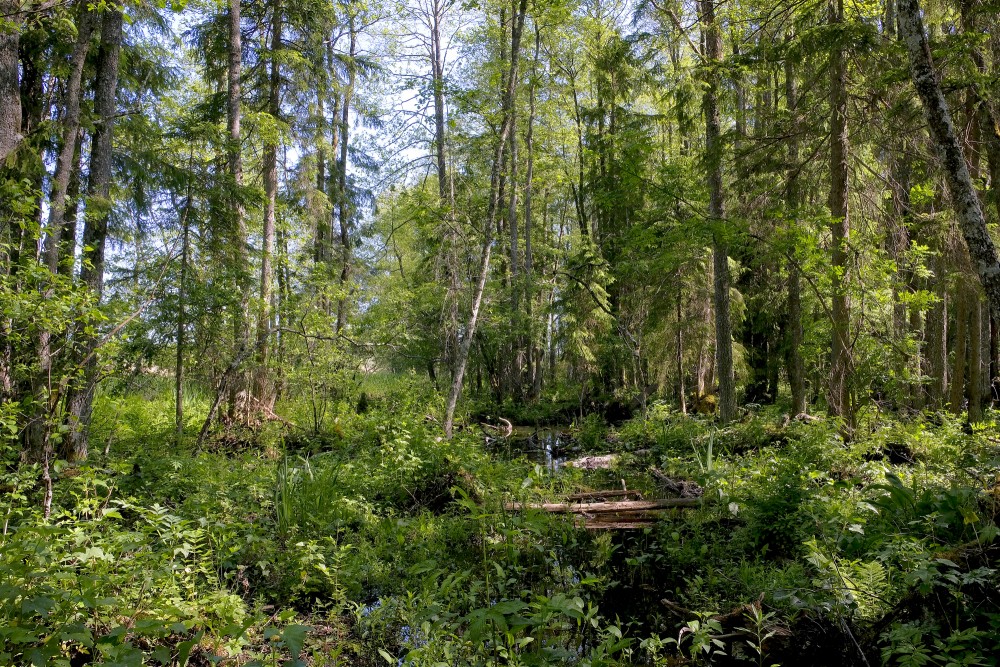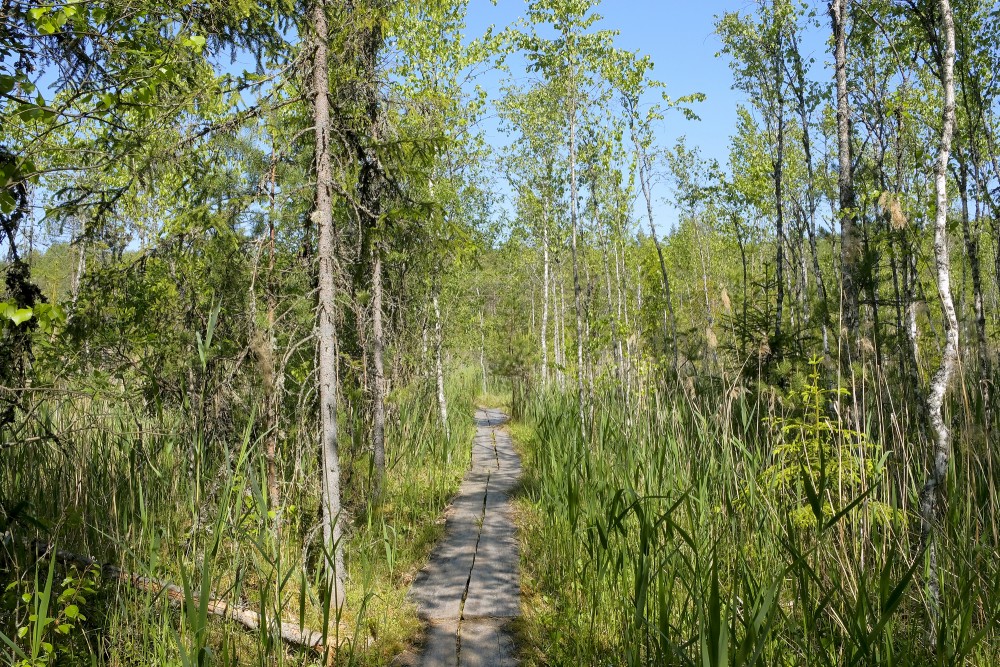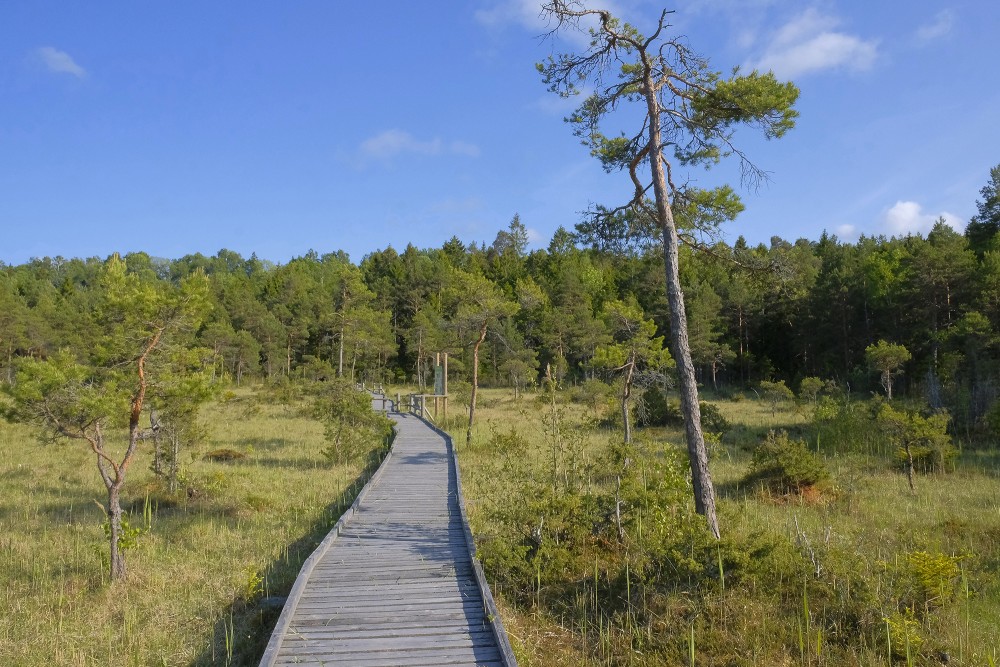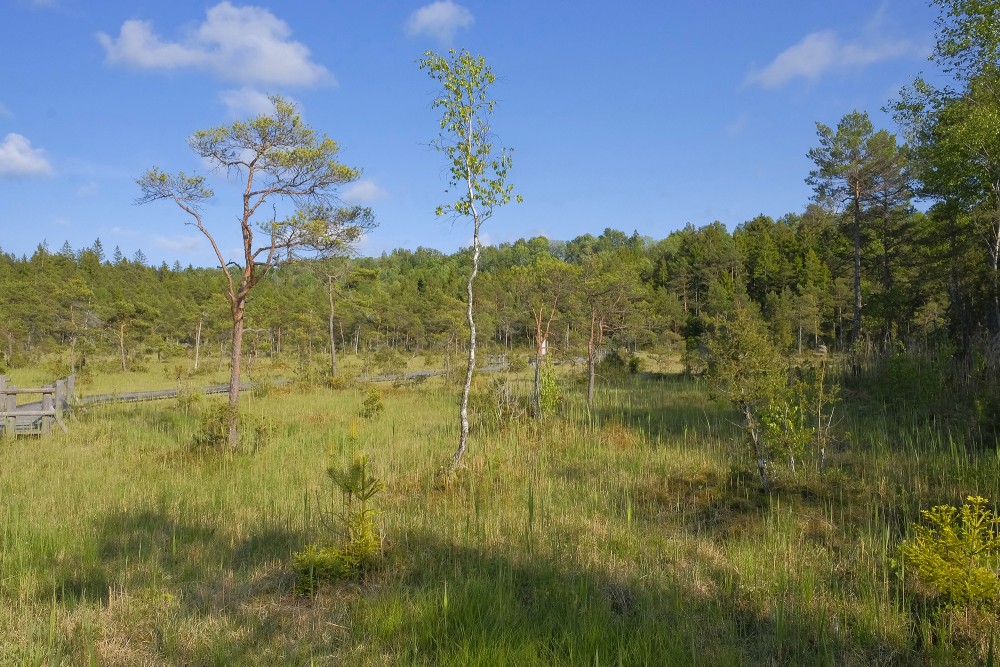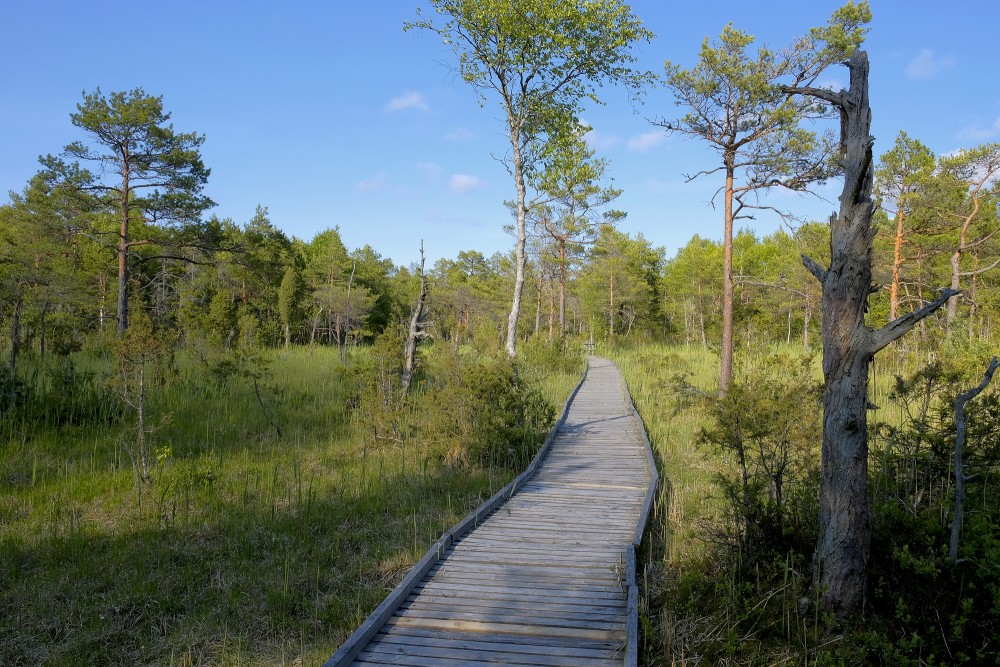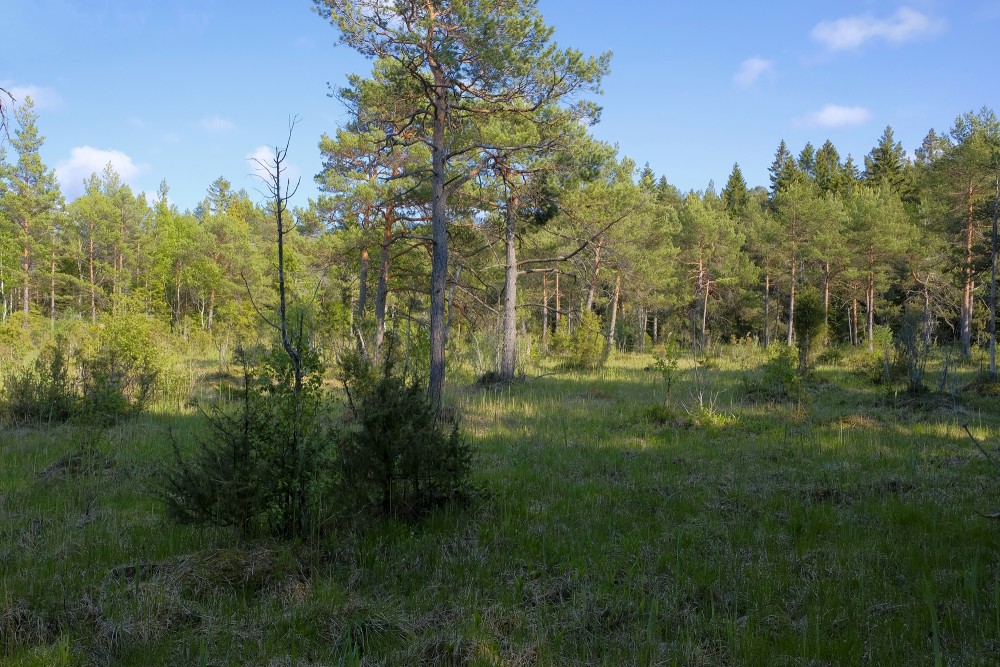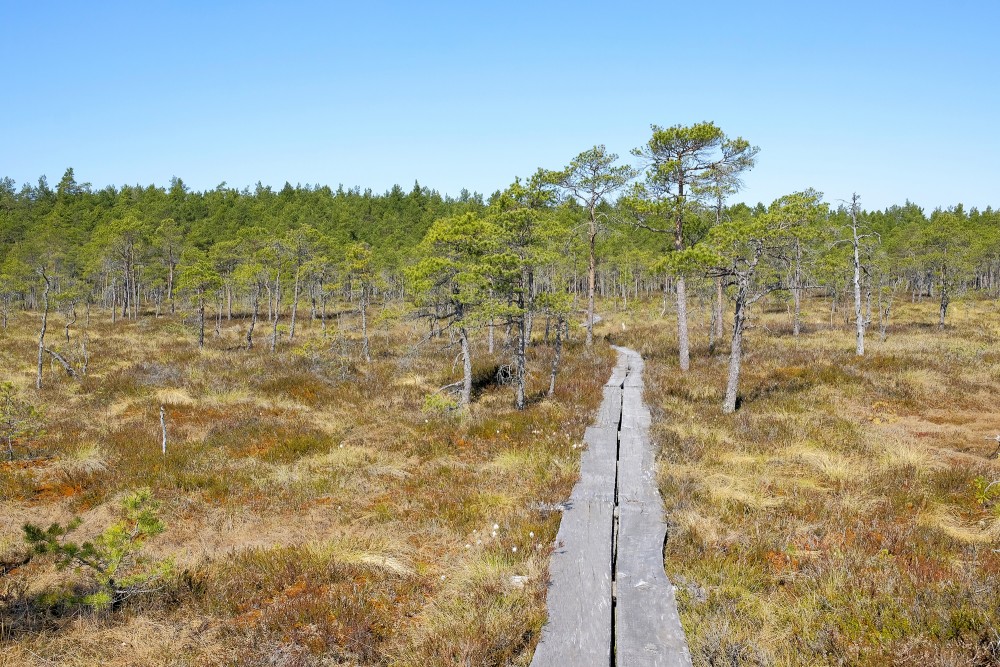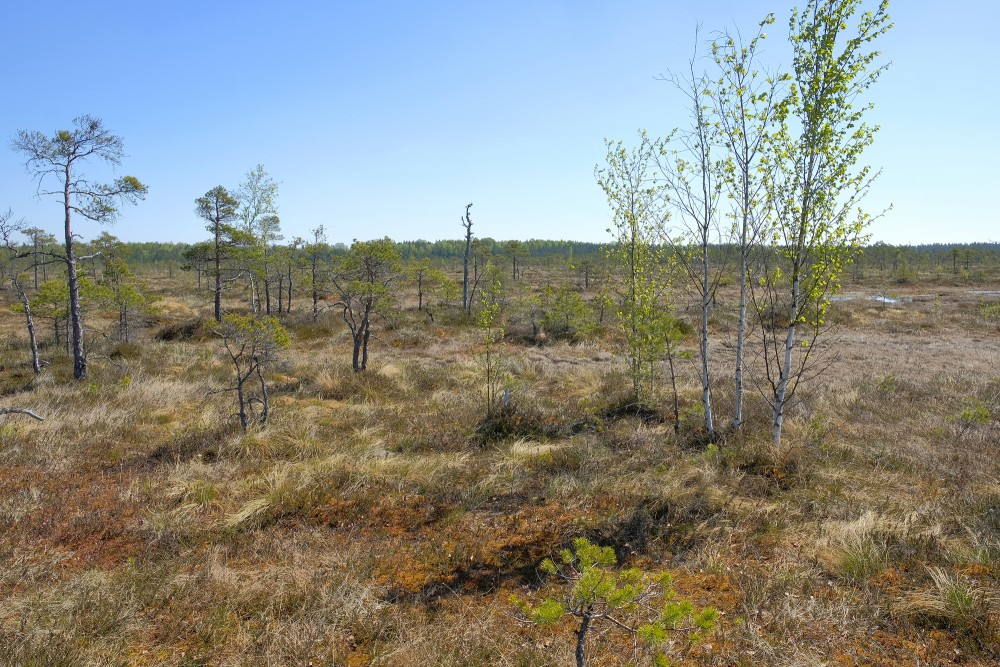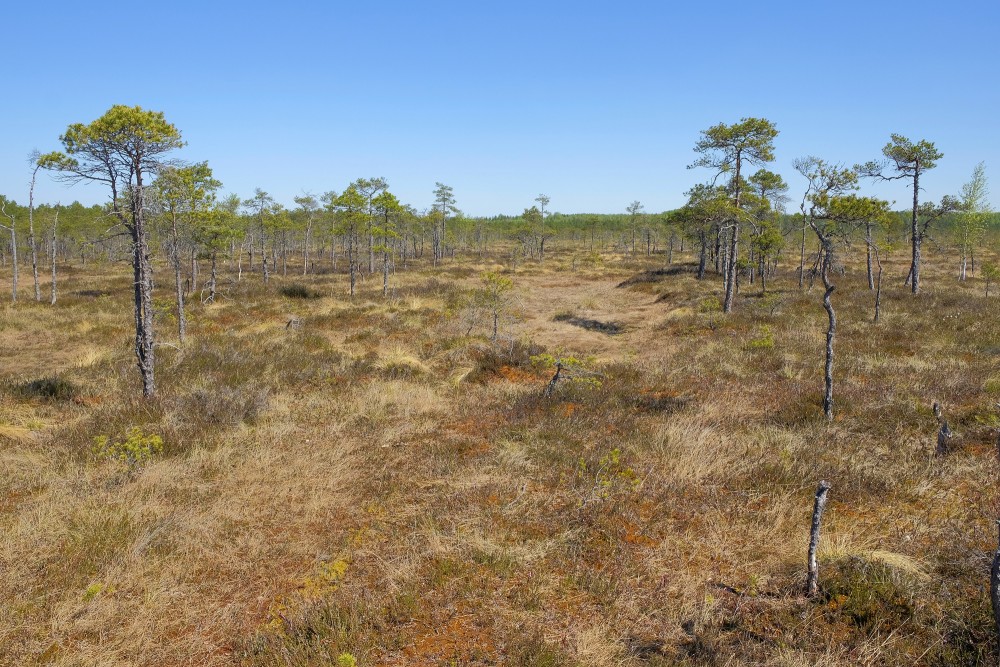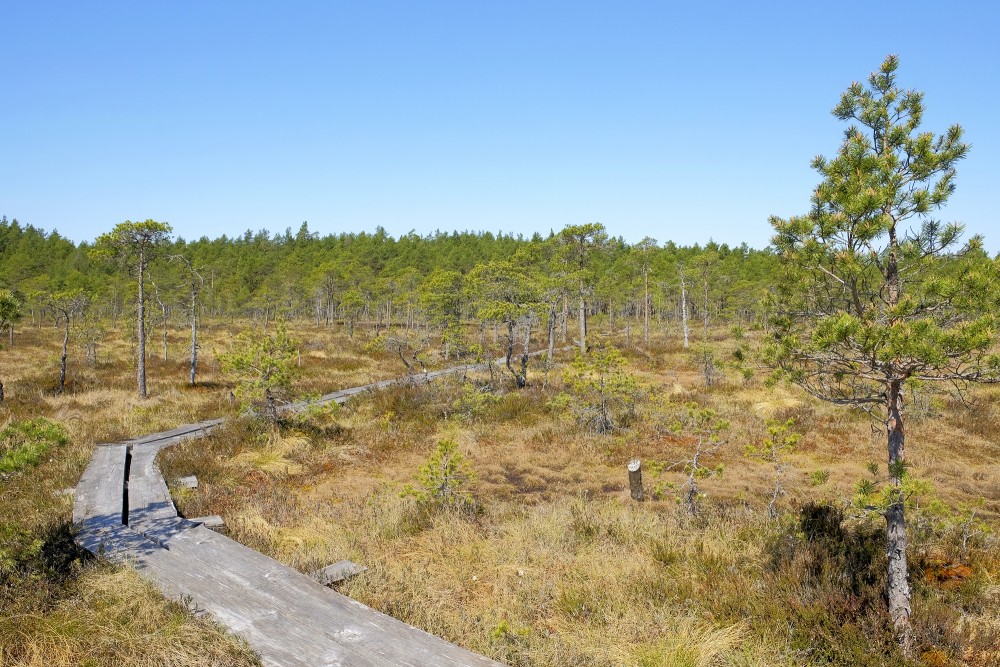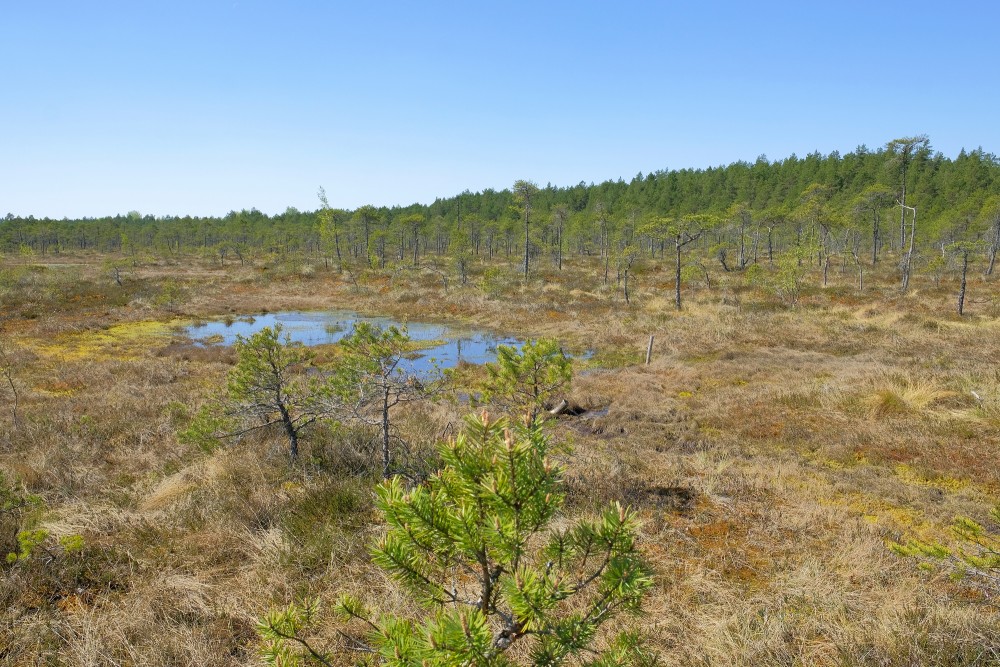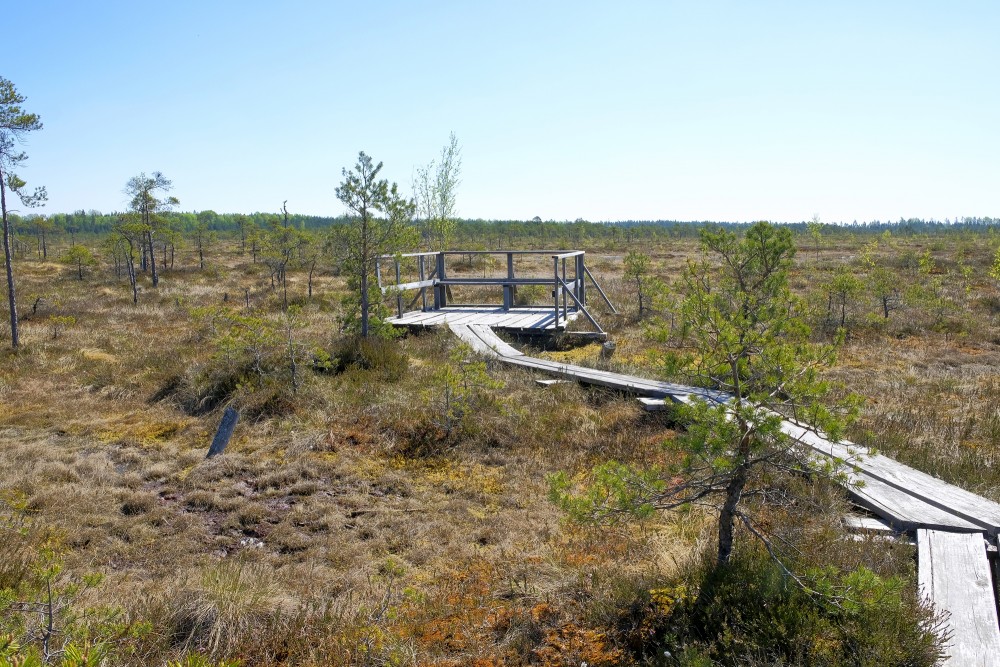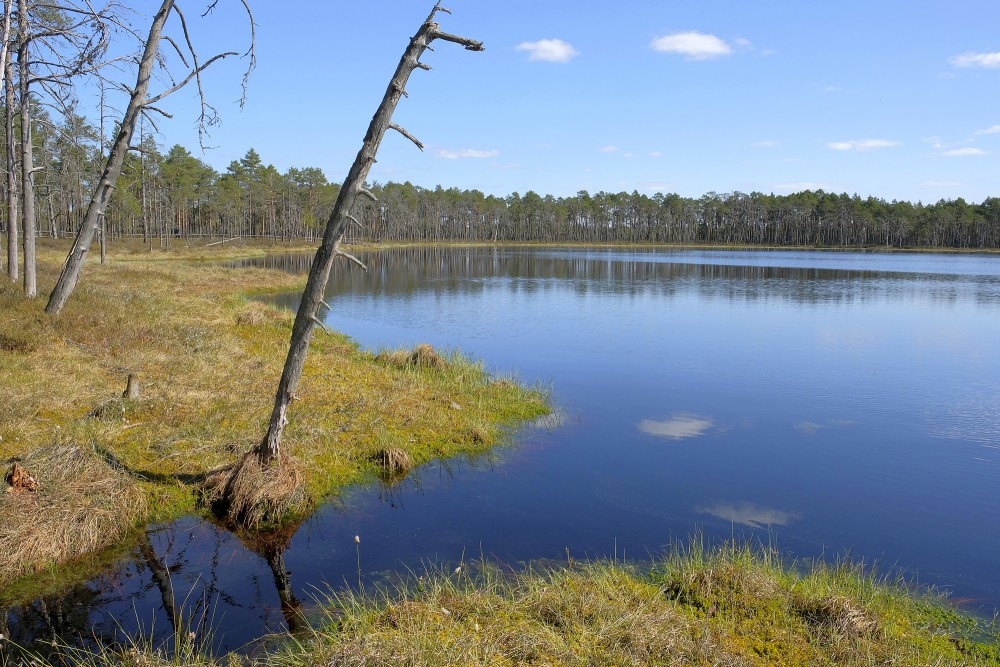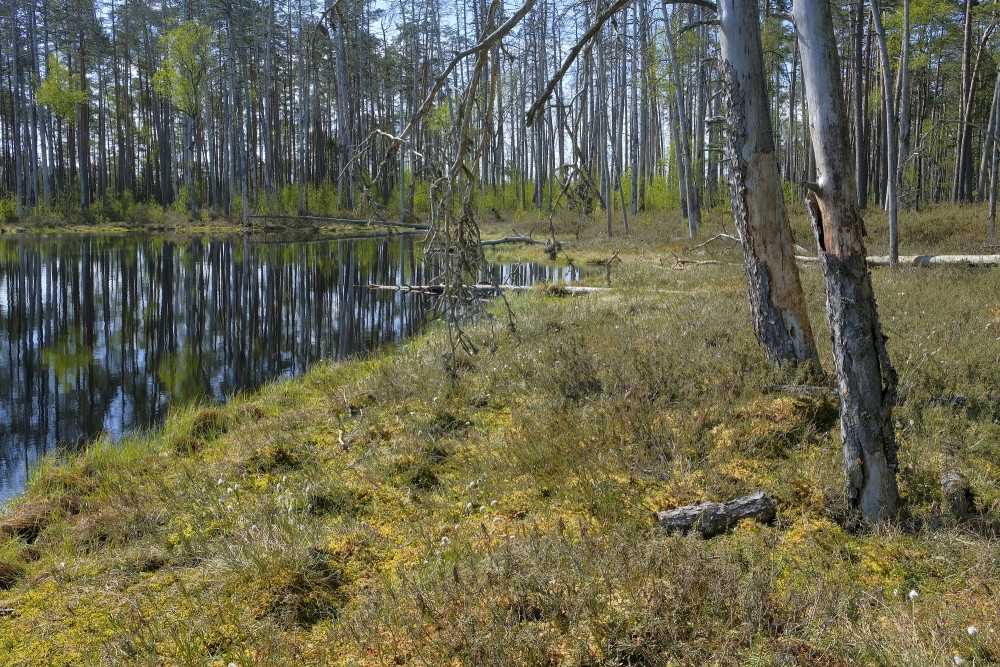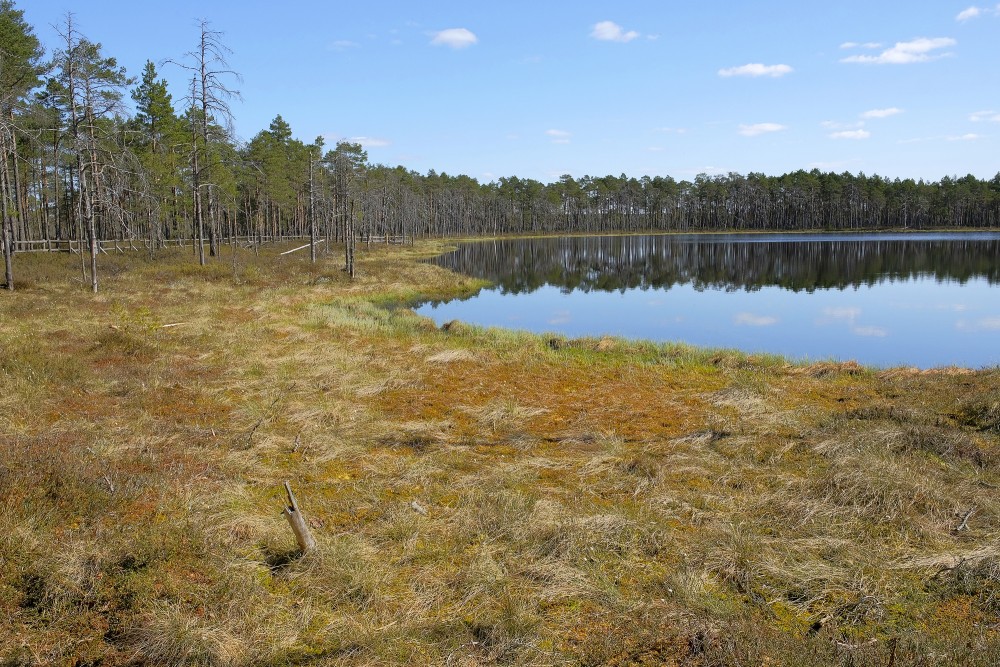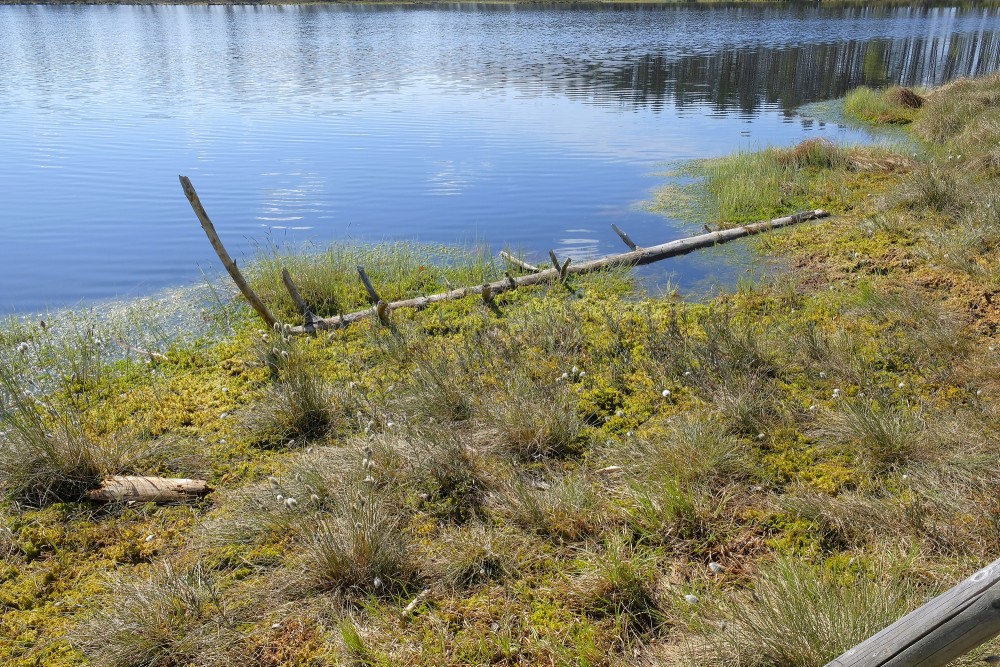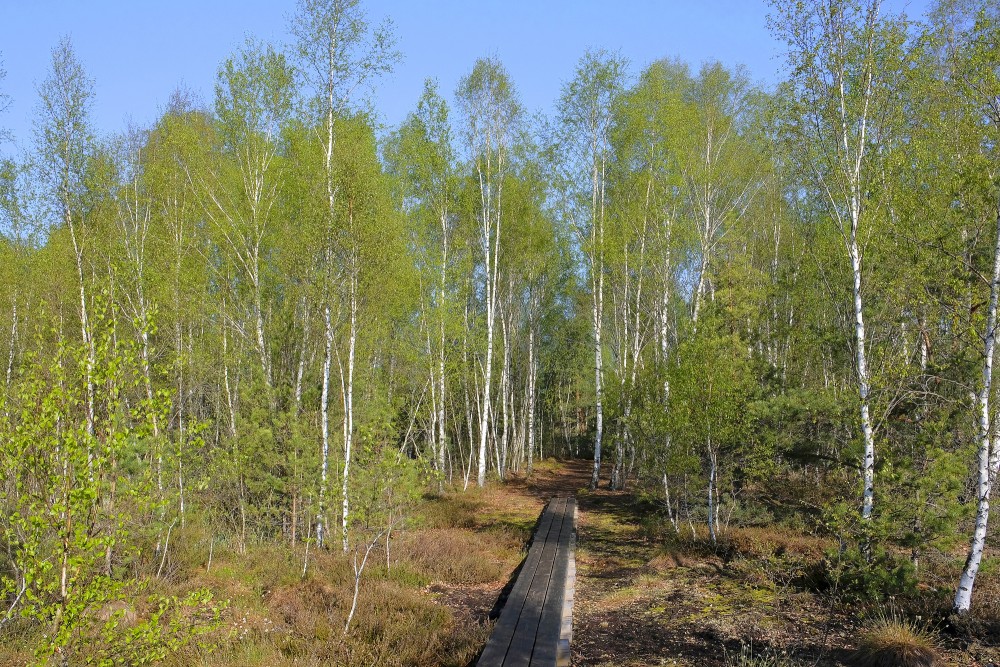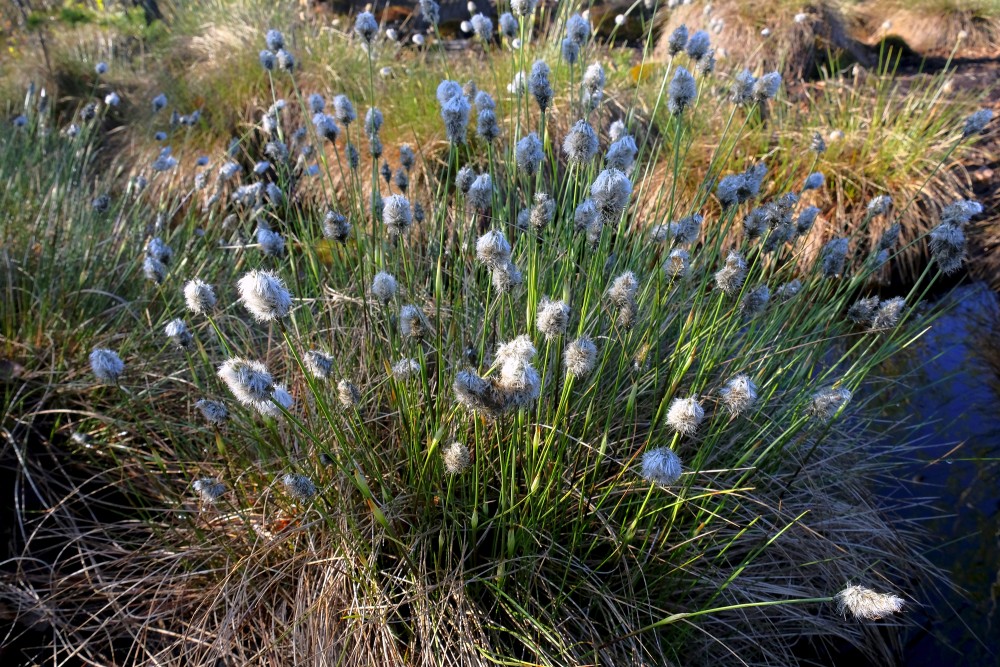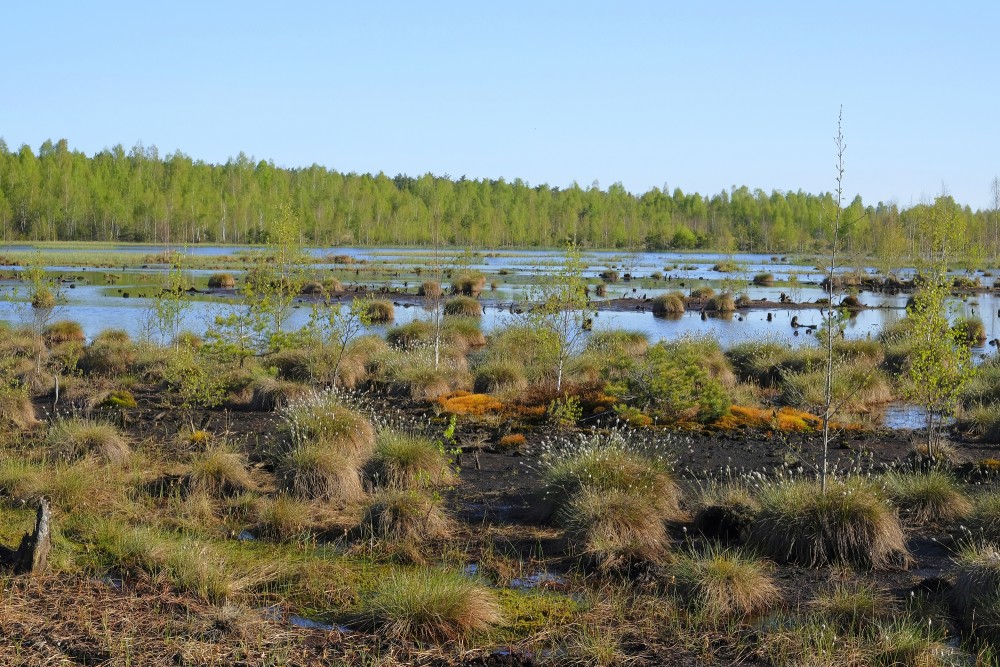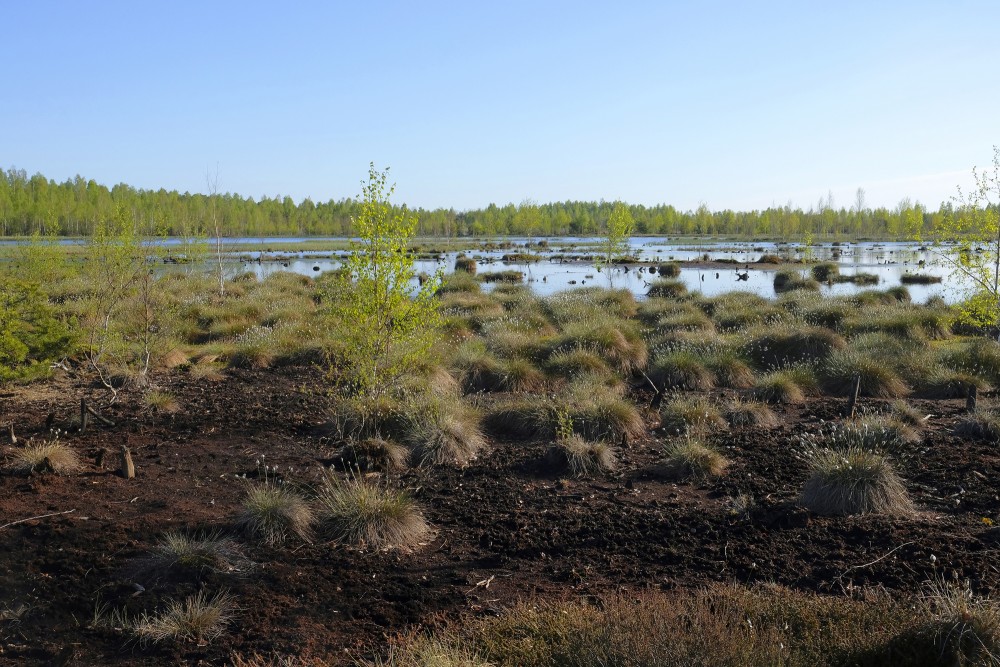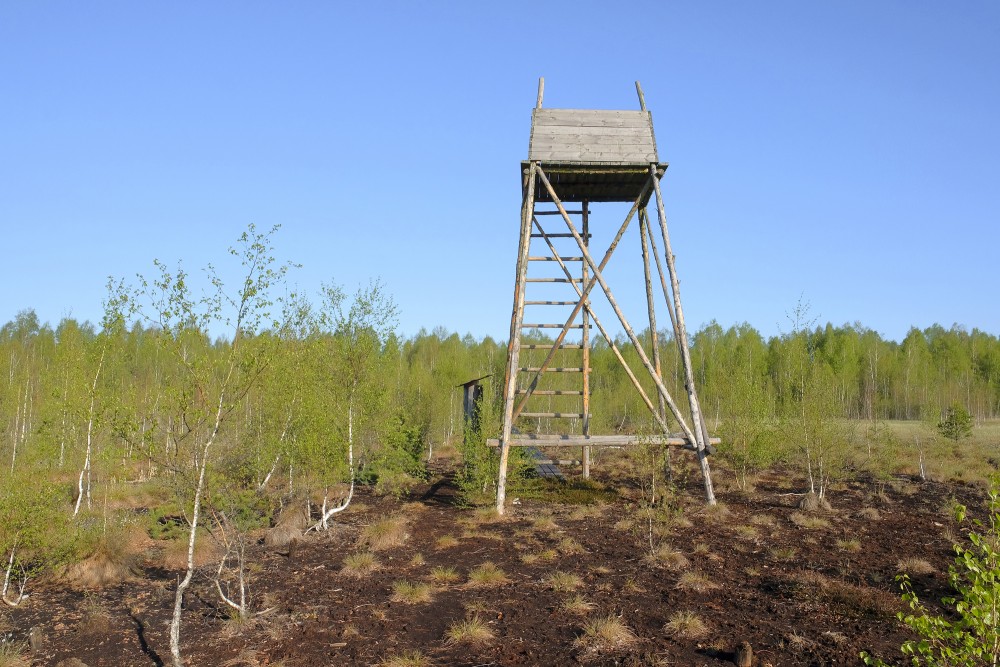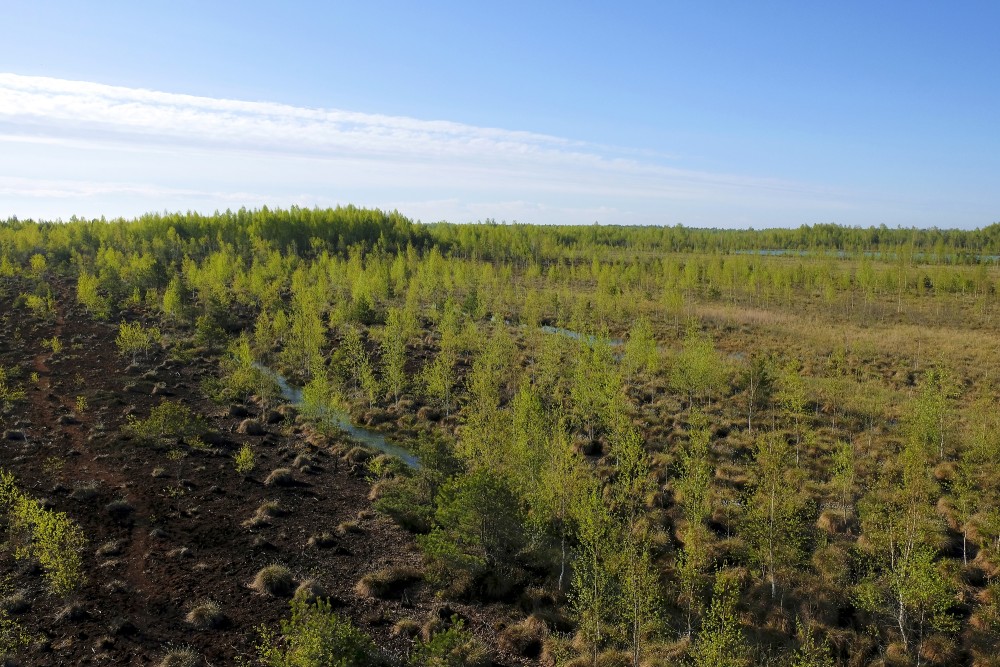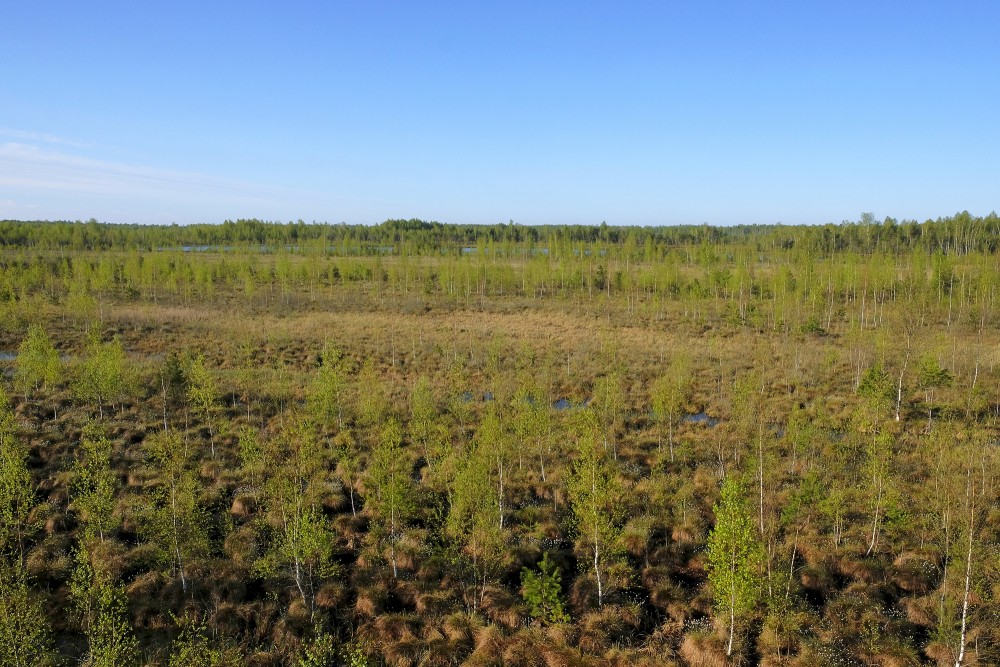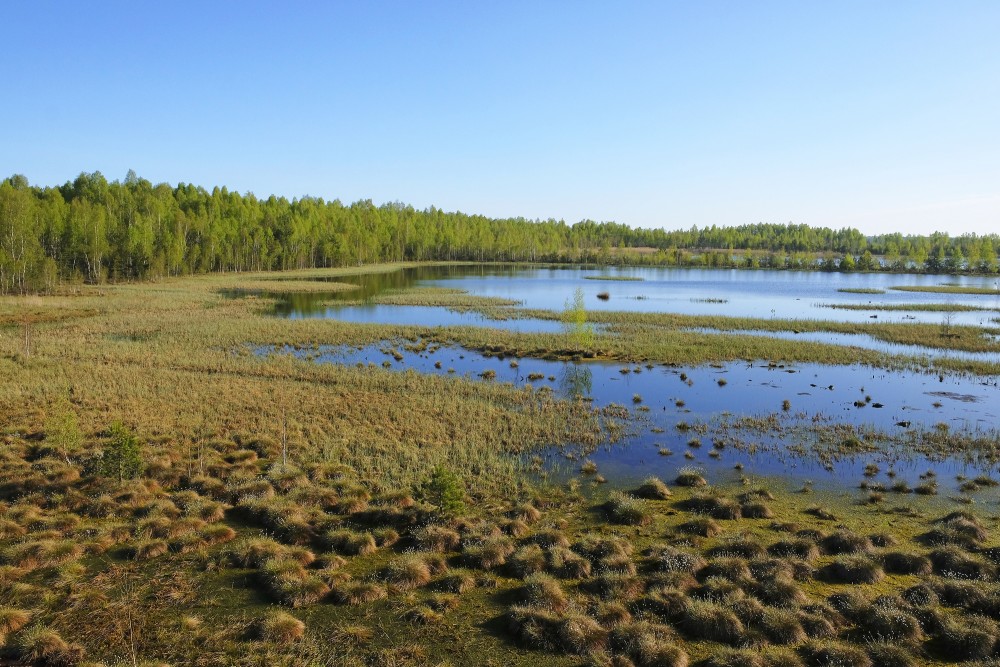Bog
A bog is a wetland that accumulates peat, a deposit of dead plant material -often mosses, and in a majority of cases, sphagnum moss. It is one of the four main types of wetlands. Other names for bogs include mire, quagmire, and muskeg; alkaline mires are called fens. They are frequently covered in ericaceous shrubs rooted in the sphagnum moss and peat. The gradual accumulation of decayed plant material in a bog functions as a carbon sink.
Bogs occur where the water at the ground surface is acidic and low in nutrients. In some cases, the water is derived entirely from precipitation, in which case they are termed ombrotrophic (cloud-fed). Water flowing out of bogs has a characteristic brown colour, which comes from dissolved peat tannins. In general, the low fertility and cool climate result in relatively slow plant growth, but decay is even slower owing to the saturated soil. Hence, peat accumulates. Large areas of the landscape can be covered in many meters deep in peat.
Bogs have distinctive assemblages of animal, fungal and plant species, and are of high importance for biodiversity, particularly in landscapes that are otherwise settled and farmed.
Distribution and extent
Bogs are widely distributed in cold, temperate climes, mostly in boreal ecosystems in the Northern Hemisphere. The world's largest wetland is the peat bogs of the Western Siberian Lowlands in Russia, which cover more than a million square kilometres. Large peat bogs also occur in North America, particularly the Hudson Bay Lowland and the Mackenzie River Basin. They are less common in the Southern Hemisphere, with the largest being the Magellanic moorland, comprising some 44,000 square kilometres. Sphagnum bogs were widespread in northern Europe but have often been cleared and drained for agriculture.
A 2014 expedition leaving from Itanga village, Republic of the Congo, discovered a peat bog "as big as England" which stretches into neighboring Democratic Republic of Congo.
Habitats
There are many highly specialised animals, fungi, and plants associated with bog habitat. Most are capable of tolerating the combination of low nutrient levels and waterlogging. Sphagnum is generally abundant, along with ericaceous shrubs. The shrubs are often evergreen, which is understood to assist in conservation of nutrients. In drier locations, evergreen trees can occur, in which case the bog blends into the surrounding expanses of boreal evergreen forest. Sedges are one of the more common herbaceous species. Carnivorous plants such as sundews (Drosera) and pitcher plants (for example Sarracenia purpurea) have adapted to the low-nutrient conditions by using invertebrates as a nutrient source. Orchids have adapted to these conditions through the use of mycorrhizal fungi to extract nutrients. Some shrubs such as Myrica gale (bog myrtle) have root nodules in which nitrogen fixation occurs, thereby providing another supplemental source of nitrogen.
Bogs are recognized as a significant/specific habitat type by a number of governmental and conservation agencies. They can provide habitat for mammals, such as caribou, moose, and beavers, as well as for species of nesting shorebirds, such as Siberian cranes and yellowlegs. The United Kingdom in its Biodiversity Action Plan establishes bog habitats as a priority for conservation. Russia has a large reserve system in the West Siberian Lowland. The highest protected status occurs in Zapovedniks (IUCN category IV); Gydansky and Yugansky are two prominent examples. Bogs even have distinctive insects; English bogs give a home to a yellow fly called the hairy canary fly (Phaonia jaroschewskii), and bogs in North America are habitat for a butterfly called the bog copper (Lycaena epixanthe). In Ireland, the viviparous lizard, the only known reptile in the country, dwells in bogland.
Types
Bog habitats may develop in various situations, depending on the climate and topography.
By location and water source
One way of classifying bogs is based upon their location in the landscape, and their source of water.
Valley bog
These develop in gently sloping valleys or hollows. A layer of peat fills the deepest part of the valley, and a stream may run through the surface of the bog. Valley bogs may develop in relatively dry and warm climates, but because they rely on ground or surface water, they only occur on acidic substrates.
Raised bog
These develop from a lake or flat marshy area, over either non-acidic or acidic substrates. Over centuries there is a progression from open lake, to a marsh, to a fen (or on acidic substrates, valley bog), to a carr, as silt or peat accumulates within the lake. Eventually, peat builds up to a level where the land surface is too flat for ground or surface water to reach the center of the wetland. This part, therefore, becomes wholly rain-fed (ombrotrophic), and the resulting acidic conditions allow the development of bog (even if the substrate is non-acidic). The bog continues to form peat, and over time a shallow dome of bog peat develops into a raised bog. The dome is typically a few meters high in the center and is often surrounded by strips of fen or other wetland vegetation at the edges or along streamsides where groundwater can percolate into the wetland.
The various types of raised bog may be divided into:
Coastal bog
Plateau bog
Upland bog
Kermi bog
String bog
Palsa bog
Polygonal bog
Blanket bog
In cool climates with consistently high rainfall (on more than c. 235 days a year), the ground surface may remain waterlogged for much of the time, providing conditions for the development of bog vegetation. In these circumstances, bog develops as a layer "blanketing" much of the land, including hilltops and slopes. Although a blanket bog is more common on acidic substrates, under some conditions it may also develop on neutral or even alkaline ones, if abundant acidic rainwater predominates over the groundwater. A blanket bog cannot occur in drier or warmer climates, because under those conditions hilltops and sloping ground dry out too often for peat to form – in intermediate climates a blanket bog may be limited to areas which are shaded from direct sunshine. In periglacial climates a patterned form of blanket bog may occur, known as a string bog. In Europe, these mostly very thin peat layers without significant surface structures are distributed over the hills and valleys of Ireland, Scotland, England and Norway. In North America, blanket bogs occur predominantly in Canada east of Hudson Bay. These bogs are often still under the influence of mineral soil water (groundwater). Blanket bogs do not occur north of the 65th latitude in the northern hemisphere.
Quaking bog
A quaking bog is a form of bog occurring in wetter parts of valley bogs and raised bogs and sometimes around the edges of acidic lakes. The bog vegetation, mostly sphagnum moss anchored by sedges (such as Carex lasiocarpa), forms a floating mat approximately half a meter thick on the surface of the water or on top of very wet peat. White spruces are also common in this bog regime. Walking on the surface causes it to move – larger movements may cause visible ripples on the surface, or they may even make trees sway. In the absence of disturbance from waves, the bog mat may eventually cover entire bays or even entire small lakes. Bogs at the edges of lakes may become detached and form floating islands.
Cataract bog
A cataract bog is a rare ecological community formed where a permanent stream flows over a granite outcropping. The sheeting of water keeps the edges of the rock wet without eroding the soil, but in this precarious location, no tree or large shrub can maintain a roothold. The result is a narrow, permanently wet habitat.
By nutrient content
Bogs may also be classified by the nutrient content of the peat.
Eutrophic bog
A eutrophic bog, also called a minerotrophic bog, is one that lies on top of fen-peat. As a result, its water is rich in nutrients. They are found in temperate regions. Fens are an example of this kind of bog.
Mesotrophic bog
A mesotrophic bog, also called a transitional peat bog, contains a moderate quantity of nutrients.
Oligotrophic bog
Oligotrophic bogs occur where the groundwater is poor in nutrients e.g. in wetlands with nutrient-poor soils. They occur in several variants: raised bogs, soligenic bogs and blanket bog.
en.wikipedia.org
